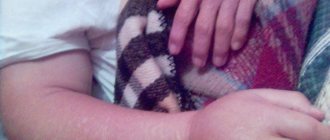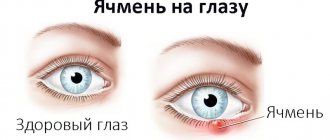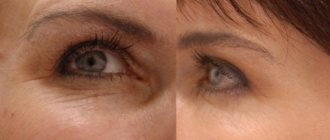Strabismus is an anomaly associated with a displacement of the visual axes. The eyes do not focus on one point at a certain point in time, the brain receives a distorted image, and visual acuity decreases. This pathology can be corrected both surgically and therapeutically.
Strabismus is a congenital disease. However, it can also arise during the formation of vision when the work of the eye muscles is coordinated. The reasons for the appearance of an anomaly may be:
- Genetic predisposition;
- Refractive errors (myopia, hyperopia, astigmatism);
- Infectious diseases;
- Psychosomatic;
- Regular stress;
- Diseases of the central nervous system.
There are two types of strabismus: friendly and paralytic. The first is characterized by deviation of the eyes from the norm in any position at the same distance. The second is caused by muscular paralysis of one of the visual organs.
In addition, the pathology (depending on the position of the pupils) can be vertical, divergent and mixed.
The benefits of gymnastics
Strabismus develops when the muscles of the eye are weak or tense. If the position of the eye is abnormal, vision also suffers.
Properly selected exercises balance muscle tension, improve visual focusing and eliminate discomfort and fatigue of the visual organ.
Thanks to the restoration of synchronicity of eye movements, the eyes gradually occupy the correct position relative to the common axis and each other. The process takes time.
There are contraindications; if possible, consult with your treating ophthalmologist.
Principle of conducting classes
All sets of exercises should be organized according to the following algorithm:
- Exercises to relax the muscles to allow the eyeballs to move together.
- The complex includes exercises that require focusing on a common point.
- The exercises should help you combine images from both eyes.
Seeing the correct dynamics after gymnastics, you should not stop. It is important to continue to systematically train the organs of vision, even when the pathology has already been corrected. This helps prevent relapse because the muscles that are prone to dysfunction can relax again.
Contraindications
Eye exercises are contraindicated for retinal detachment and glaucoma until the pathology is eliminated.
After surgery, exercise is also unacceptable for 6–7 months. After the postoperative period, you can begin training with exercises using the Zhdanov method, but only after consultation with a specialist.
Rules of therapeutic exercises
To achieve this goal, it is important to follow the basic rules of therapeutic exercises to restore the correct position of the eyes.
The main rule of therapeutic exercises is systematicity. The best option would be to perform the complex daily at a certain time. Every day you need to allocate at least 15 minutes for gymnastics, divided into several approaches. Several treatment techniques can be combined:
- Exercises should be performed with special corrective glasses.
- Classes should be conducted in a calm environment; the patient should be relaxed and feel comfortable.
- You need to repeat the exercises at least 16 times.
- Immediately before performing the movements, it is important to relax your eyes. To do this, close your eyelids and sit quietly for 2-3 minutes. If you have trouble relaxing, you can place a clean, slightly heated towel over your eyes. The warmth and absence of light will relax the eye muscles and relieve eye tension.
- To relieve dry eyes, blink quickly 3-5-6 times.
- After the load received as a result of gymnastics, it is important to relax the muscles. For this purpose, relaxation of the eyes with closed eyelids, massage or self-massage are used.
Gymnastics is performed in daylight or dim light. Bright light and glare surfaces strain the eye muscles and optic nerve.
Treatment options
In addition to wearing glasses to correct vision and strabismus, certain exercises can help. It needs to be done at home.
All types of exercise must be repeated at least 16 times every day, then the treatment can be called effective.
Experts give some tips on how to properly prepare for tasks:
- You need to relax your eyes as much as possible, which will lead to synchronous movement of the eyeballs in both eyes.
- Focus your gaze on a specific point (any).
- It is recommended to start exercises when the conditions are calm, you are not in a hurry and can fully concentrate on the task at hand.
Exercises for convergent and divergent strabismus
Exercises for strabismus in adults are selected individually and require a longer duration of exercise to achieve the effect.
Depending on the position of the eyes—closer to the bridge of the nose or temples—convergent and divergent strabismus are distinguished. The basic principles of treatment are the same, but each type of pathology has its own characteristics.
Treatment of convergent strabismus
With convergent strabismus, there is a reduction of the eyes to the nose; the main goal of the exercises is to restore muscle balance.
To train your eye muscles, make a special mask from ordinary cardboard, designed to develop correct focusing. You will have to wear it for a long time. Cut out a carnival-type mask from cardboard. When forming the holes, it is important to ensure that the holes are slightly away from the center of the pupil towards the temples. It is better to select the dimensions and distance between the holes individually from the treating ophthalmologist.
The second option is to cover regular glasses with adhesive tape or thick cardboard and cut a hole in the center for the eyes.
These training glasses are used when watching movies, reading books, working on a computer or doing handicrafts.
The essence of the simulator is to correctly restore the position of the eyes. Training time – from 10 minutes in the first days, gradually increase the time of wearing the mask to 30 minutes.
In addition to training glasses, there are active exercises that solve this ophthalmological problem:
- Place a small object, preferably a bright one, on the table in front of you. Cover one eye with your hand and focus on the selected object. Slowly turn your head without moving your eyes.
- This exercise is best done at dawn in clear weather. Stand facing the sun. Cover one eye with your hand and try to see the sun's rays with the other. Slowly turn your head in the direction opposite to the closed eye.
Perform exercises for both eyes, even if the problem is with the position of only one.
Treatment with movement for a divergent type of disorder
To train the organ of vision, it is not necessary to use all training options; it is enough to select one or two movements. The main thing in this matter is systematicity:
- Choose 5-6 minutes to complete the exercise. Focus your averted eye on the tip of your nose for 7–10 seconds, relax, allowing the muscles to return to their usual position for 4–5 seconds. Perform the movement 16-20 times, you can do several approaches per day.
- From a standing position with your arms extended in front of you, follow the extended index finger with your eyes. At the same time, slowly move your hand to the tip of your nose and return it in front of you. Good to do after and before bed.
- A highly effective exercise is drawing with your eyes. The main line will be drawing the number 8 and the infinity sign. You can also draw a diagonal figure eight or just a line in one direction or the other. During exercise, change the speed from slow to fast and vice versa.
Simple movements will help restore the anatomically correct position of the eyes, and with it improve vision. The main thing in this matter is not to be lazy and strive for your health. Strabismus is a pathology with a favorable outcome with timely treatment.
Hardware treatment of strabismus in adults
To date, various technical systems designed for non-surgical correction of strabismus have been developed and introduced into world ophthalmological practice. Their effectiveness, despite the still widespread skeptical and distrustful attitude, is very high. As a rule, a hardware training course takes 10-20 days and includes the use of 4-5 devices; one session lasts, on average, from 40 to 70 minutes.
In particular, both for diagnostic purposes and for the restoration of binocular vision, devices of the “Synoptophore” type are used - the principle of operation of devices of this class is the separate, independent presentation of images to the right and left eyes (for example, if the squinting eye sees a plate, and the healthy eye sees a cutlet , the patient must, through an effort of will and visual imagination, visualize the image of a cutlet on a plate). Such techniques, which require high motivation and perseverance from the patient, in most cases make it possible to get rid of strabismus without surgical intervention.
Exercises using the Zhdanov method
Treatment with gymnastics according to the Zhdanov method consists of daily repetition of simple actions:
- Sit up straight and relax. Rub your previously washed and dried palms against each other until heat appears in them. Press firmly to your face so that you completely close your eyes, but do not put pressure on them.
- Try to remember something pleasant and calm. The simultaneous exposure to the warmth of the palms, darkness and bright thoughts leads to relaxation of the eye muscles.
- Turn off all the lights in the room. Place a lit candle on the table. Both eyes should look at the tip of the nose. Slowly turn your head from side to side, keeping your eyes in the indicated position, try not to look at the candle. Instead of a candle, you can use a switched-on table lamp. Perform the exercise 16–20 times.
After 2-3 months of daily training, the first positive result will be noticeable. To achieve your goal, it is important not to skip eye exercises and do them daily.
An effective set of exercises
When misalignment occurs only in certain situations, for example, too much tension. To correct this, special rehabilitation training is required. The most effective of all eye exercises for strabismus include:
- You need to try to make sure that the affected eye can look in the direction opposite to the distortion. Sit down and put some object in front of you. When your left eye squints, close your right eye. Turn your head to the right side, without taking your eyes off the object of concentration.
- In addition to observing stationary objects, as in the previous paragraph, you should track the object in dynamics. A clock pendulum is suitable for this.
- Take any object in your hand extended in front of you so that it is at the same level as your eyes. Try to concentrate the attention of both eyes at once. If it doesn’t work, then concentrate on at least the affected analyzer, then connect a second one. The main purpose of the exercise is to synchronize work.
- Close your eye, try to draw an imaginary infinity sign with the other, do 10 repetitions. Do the same with the second, then repeat with two at once. This is a simple but effective exercise, but for positive results of correction it must be done regularly.
Gymnastics for children
Treatment of childhood strabismus requires a special approach, taking into account the form of the pathology and the age of the patient. Parents are entirely responsible for the performance of gymnastics by young children; high school students can conduct classes independently, but they need reminders.
Strabismus in childhood can be easily corrected.
The game “find the differences” gives a good treatment effect. To do this you will need a variety of pictures with differences.
To treat childhood strabismus, the dividing line in the pictures to find differences must be vertical!
Exercise for the little ones
Try to choose a time when your baby is calm, relaxed and in a good mood. While playing, close one of your baby's eyes and slowly move a bright rattle in front of the other. The child must follow the moving object. It is important to do gymnastics on both sides, even if the problem is observed only on one.
Classes for children over 3 years old
Take a sheet of paper and divide it into 2 parts. On each half, place geometric shapes cut out of colored paper in a random order. The child’s task is to find a pair for each figure. You can also use cards of animals, plants, household items and clothing.
For variety, pairs are used: for example, find mom. Place baby animals on one side and adults on the other. Combinations can be different, as well as tasks.
Game “Maze”: print out several pictures with labyrinths of varying complexity (you can cut them out from different magazines). The child’s task is to follow the path through the labyrinth with his eyes. If the child is small, start with the simplest ones.
In addition to gymnastics at home, the child can be taken for treatment to an ophthalmological day hospital or a sanatorium. In specialized centers there are special eye simulators.
You may need to wear a patch on the unaffected eye for up to 4 months. This method is aimed at activating the work of the open eye. The muscles gradually return to normal. When wearing a bandage, it is important to perform gymnastics for the healthy eye so as not to get a similar problem.
Recommendations
In childhood, glasses are required, the selection of which is carried out by a specialist, and very carefully, because incorrectly selected optics can worsen the vision situation. Glasses are supposed to be worn all the time, so you need to have one or two pairs in reserve. Sometimes the healthy eye is covered with a patch to make the affected eye work better in terms of concentrating vision.
Such therapy will not help adults; they need therapeutic exercises, which need to be done often - from 15 to 20 times a day, evenly distributed over time. You need to definitely tune in to the exercises, relaxing your muscles, this is necessary so that your eyes make synchronous movements and can focus in a certain place.
It’s much easier for adults to do than for children, because you don’t need to turn the activity into a game, but you still need to do the exercises so often, in fact every half hour, that you still need to interest yourself in something and thus achieve greater efficiency.











